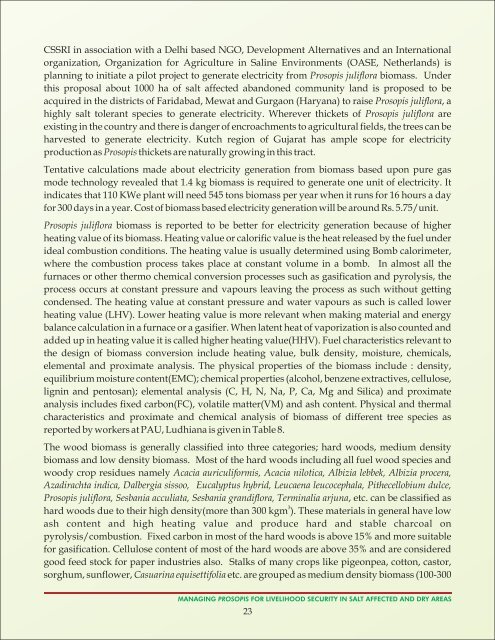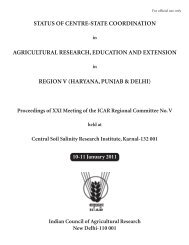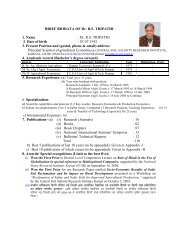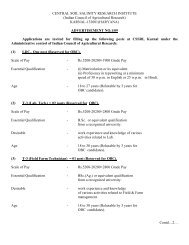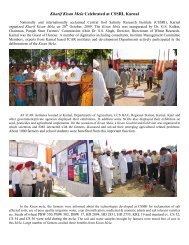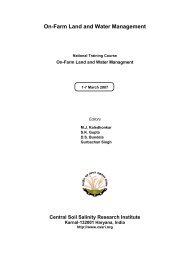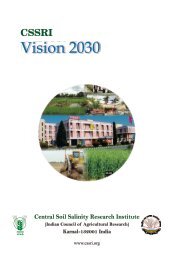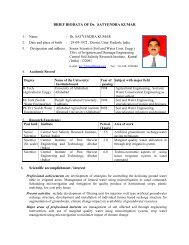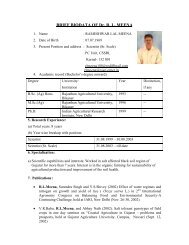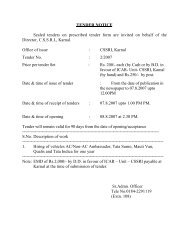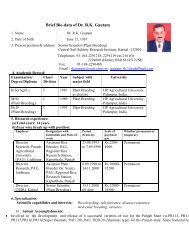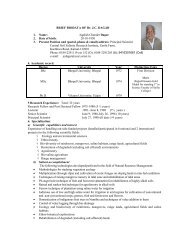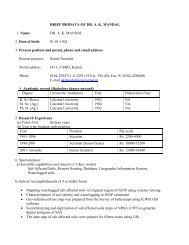details - Central Soil Salinity Research Institute
details - Central Soil Salinity Research Institute
details - Central Soil Salinity Research Institute
- No tags were found...
You also want an ePaper? Increase the reach of your titles
YUMPU automatically turns print PDFs into web optimized ePapers that Google loves.
CSSRI in association with a Delhi based NGO, Development Alternatives and an Internationalorganization, Organization for Agriculture in Saline Environments (OASE, Netherlands) isplanning to initiate a pilot project to generate electricity from Prosopis juliflora biomass. Underthis proposal about 1000 ha of salt affected abandoned community land is proposed to beacquired in the districts of Faridabad, Mewat and Gurgaon (Haryana) to raise Prosopis juliflora, ahighly salt tolerant species to generate electricity. Wherever thickets of Prosopis juliflora areexisting in the country and there is danger of encroachments to agricultural fields, the trees can beharvested to generate electricity. Kutch region of Gujarat has ample scope for electricityproduction as Prosopis thickets are naturally growing in this tract.Tentative calculations made about electricity generation from biomass based upon pure gasmode technology revealed that 1.4 kg biomass is required to generate one unit of electricity. Itindicates that 110 KWe plant will need 545 tons biomass per year when it runs for 16 hours a dayfor 300 days in a year. Cost of biomass based electricity generation will be around Rs. 5.75/unit.Prosopis juliflora biomass is reported to be better for electricity generation because of higherheating value of its biomass. Heating value or calorific value is the heat released by the fuel underideal combustion conditions. The heating value is usually determined using Bomb calorimeter,where the combustion process takes place at constant volume in a bomb. In almost all thefurnaces or other thermo chemical conversion processes such as gasification and pyrolysis, theprocess occurs at constant pressure and vapours leaving the process as such without gettingcondensed. The heating value at constant pressure and water vapours as such is called lowerheating value (LHV). Lower heating value is more relevant when making material and energybalance calculation in a furnace or a gasifier. When latent heat of vaporization is also counted andadded up in heating value it is called higher heating value(HHV). Fuel characteristics relevant tothe design of biomass conversion include heating value, bulk density, moisture, chemicals,elemental and proximate analysis. The physical properties of the biomass include : density,equilibrium moisture content(EMC); chemical properties (alcohol, benzene extractives, cellulose,lignin and pentosan); elemental analysis (C, H, N, Na, P, Ca, Mg and Silica) and proximateanalysis includes fixed carbon(FC), volatile matter(VM) and ash content. Physical and thermalcharacteristics and proximate and chemical analysis of biomass of different tree species asreported by workers at PAU, Ludhiana is given in Table 8.The wood biomass is generally classified into three categories; hard woods, medium densitybiomass and low density biomass. Most of the hard woods including all fuel wood species andwoody crop residues namely Acacia auriculiformis, Acacia nilotica, Albizia lebbek, Albizia procera,Azadirachta indica, Dalbergia sissoo, Eucalyptus hybrid, Leucaena leucocephala, Pithecellobium dulce,Prosopis juliflora, Sesbania acculiata, Sesbania grandiflora, Terminalia arjuna, etc. can be classified as3hard woods due to their high density(more than 300 kgm ). These materials in general have lowash content and high heating value and produce hard and stable charcoal onpyrolysis/combustion. Fixed carbon in most of the hard woods is above 15% and more suitablefor gasification. Cellulose content of most of the hard woods are above 35% and are consideredgood feed stock for paper industries also. Stalks of many crops like pigeonpea, cotton, castor,sorghum, sunflower, Casuarina equisettifolia etc. are grouped as medium density biomass (100-300MANAGING PROSOPIS FOR LIVELIHOOD SECURITY IN SALT AFFECTED AND DRY AREAS23


